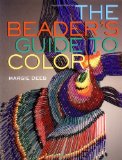|
The Beader's Guide to ColorThe Beader's Guide to Color by Margie Deeb, published by Watson-Guptill Publications, 2004. 144 pages with great color on every page A Book Review
As far as I know, The Beader's Guide to Color was the first book about color written exclusively for beaders. Color Theory and DesignThe first chunk of the book covers color theory and design. Now before you start rolling your eyes because you either think that stuff is too technical to be of interest, or you think you already know everything about it, just take a deep breath and relax. Deeb spends four pages discussing color wheels of pigment and of light, covers primary and secondary colors, and then moves along to a series of colorful 2-page spreads about individual color ranges (yellow, for example). Each color has a couple of photos of great beadwork in that color range, a nice strip of woven seed beads on the left margin, and some suggested color schemes that include delica bead numbers. She has created a standard method to illustrate how the proportion of each color to use in her suggested color schemes. While I am not crazy about the flat ovals of color she uses for this, they do provide some way of getting a general idea about how to use the colors. The flat ink shapes do not have the liveliness of the delica beads she talks about in the accompanying paragraph, and it is only by reading the text carefully that I can begin to see in my mind's eye how these beads would really look. If you are not already familiar with the range of finishes available in seed beads, your mental picture may be less compelling than mine. Each of these 2-page spreads on individual colors along the color wheel contains text that talks about meanings of the color, psychological associations, and ways that colors in this range have been used in the past. There are also suggestions for using subsets of the color, such as tints, pastels, blackened, or pure color. Following the pages on individual colors, there are discussions of intuitive color harmonies, and about the properties of color: value, intensity, and temperature. These are illustrated both with color schematics and with photos of finished jewelry and other beadwork A segment on complementary relationships includes red/green, yellow/violet, and orange/blue color schemes, as well as their versions in the light-based color wheel. The next section of The Beader's Guide to Color covers color schemes for beading based on color theory. It begins with a nice discussion of design elements of similarity and contrast, movement, rhythm and repetition, dominance, and proportion and area of extension, all illustrated with lovely examples of beadwork. There are a couple of pages about seed bead finishes including how each finish reflects or absorbs light, and some good uses of beads with each type of finish. She also addresses the finishes that are problematic for long wear. Deeb also presents color schemes of the each season of the year. Theory-Based Color SchemesThe second big chunk of the book presents 13 color schemes based on color theory. Each includes a discussion of the scheme, suggested palettes, a nice example, and a project that uses that particular type of color scheme. The projects include a few stringing projects and a lot of bead-woven projects, an area in which Margie Deeb already has a nice track record. Each bead-woven project has full color charts for both loomed/square stitch and for peyote/brick stitch; this is a nice feature that makes the projects easy to approach. In addition, all the woven projects include a modest number of colors, not the dozens of colors sometimes seen in bead charts. I think the largest number of colors I saw on her charts was 15, and many were only about half that number. Emotional & Symbolic Color SchemesAs The Beader's Guide to Color addresses color schemes with an emotional message, Margie Deeb provides nine more projects which include strung necklaces, brick stitch earrings in clashing colors, an amulet bag, a woven bracelet, and a necklace featuring wheels created from crystals. Inspiration & TechniqueDeeb has selected seven lovely pieces of exhibition-quality beadwork by seven different artists to close out the portion of the book that is about color. This is followed by a section on beading instructions that provides the necessary information to make the projects in the book. RecommendationsI recommend this book to meet three needs and desires that are common to those of us who bead: 1. A painless discussion of basic color theory and design concepts, clearly illustrated. If you have never been an art student (or could use a refresher), this is a good place to ground yourself in some principles so that you can combine your natural intuition about these issues with some time-tested ideas about what works. 2. Great color inspiration and ideas on every page, to get you thinking about your own beadwork, and looking at your stash with new eyes. 3. A good set of projects to use exactly as presented or as jumping-off points for your own alterations and wishes. The "Look Inside!" feature at Amazon.com lets you see the pages on basic color theory and a few other pages to get an idea about the book. To take a peek at the pages, follow this link to The Beader's Guide to Color Return to The Beading Book Shelf
|

